Disclaimer: This blog post contains affiliate links. If you make a purchase through these links, I may earn a small commission at no additional cost to you. Learn More. Thank you for supporting our garden community.
How to Grow Tomatoes from Seed for Beginners
Growing your own tomatoes is one of the most rewarding gardening experiences. Whether you’re a seasoned gardener or a beginner, this guide will provide you with all the information you need to successfully grow tomatoes, from selecting the right variety to harvesting your first ripe fruit. So here’s everything to know about how to grow tomatoes from seed.
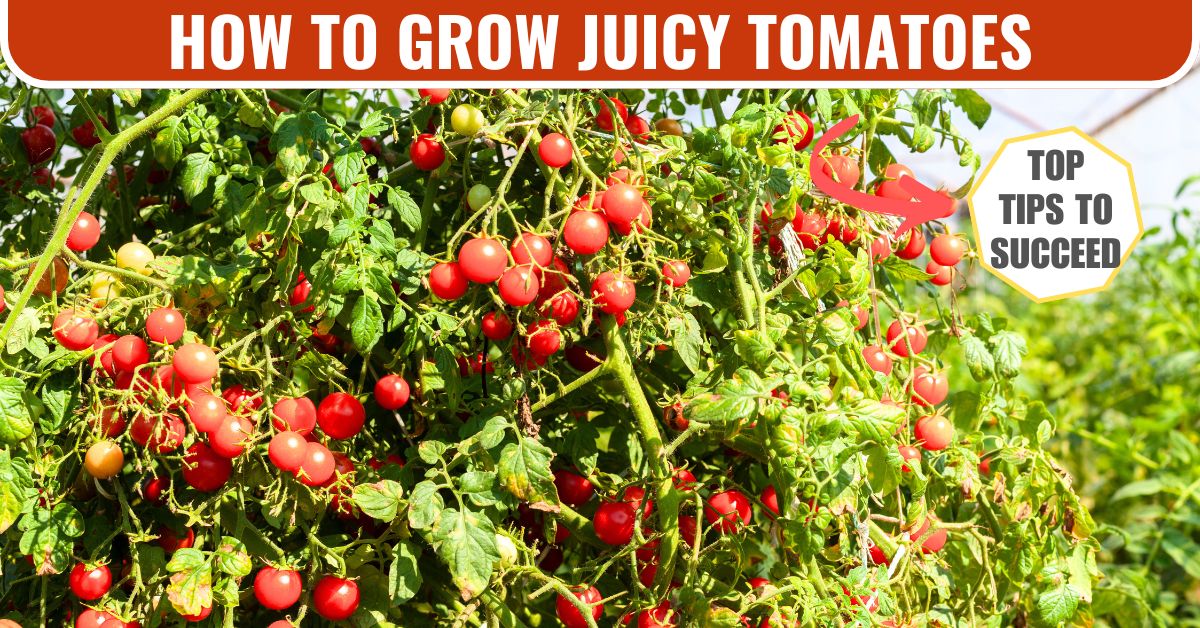
How to Grow Tomatoes
Tomatoes are a staple crop in my garden and certainly one of my favourites. I grow a few varieties every year and I try to find the best ones to keep growing.
Tomatoes are also one of the first crops that beginner gardeners try to grow, and sometimes they don’t get the best harvest. Which is unfortunate because tomatoes should be a relatively simple plant to grow.
That being said, today I will give you everything you need to know for growing tomatoes in your backyard vegetable garden.
So let’s get right into how to grow tomatoes!
Products
To buy high-quality garden seeds, check out Burpee.
For a wide selection of perennial garden plants, check out Nature Hills Nursery.
For gardening equipment, check out Bootstrap Farmer.
Choosing the Right Tomato Variety
The first step for growing tomatoes is choosing a tomato variety that suits your preferences and garden.
There are thousands of different tomato varieties, but they can generally be divided into 2 main groups: indeterminate and determinate.
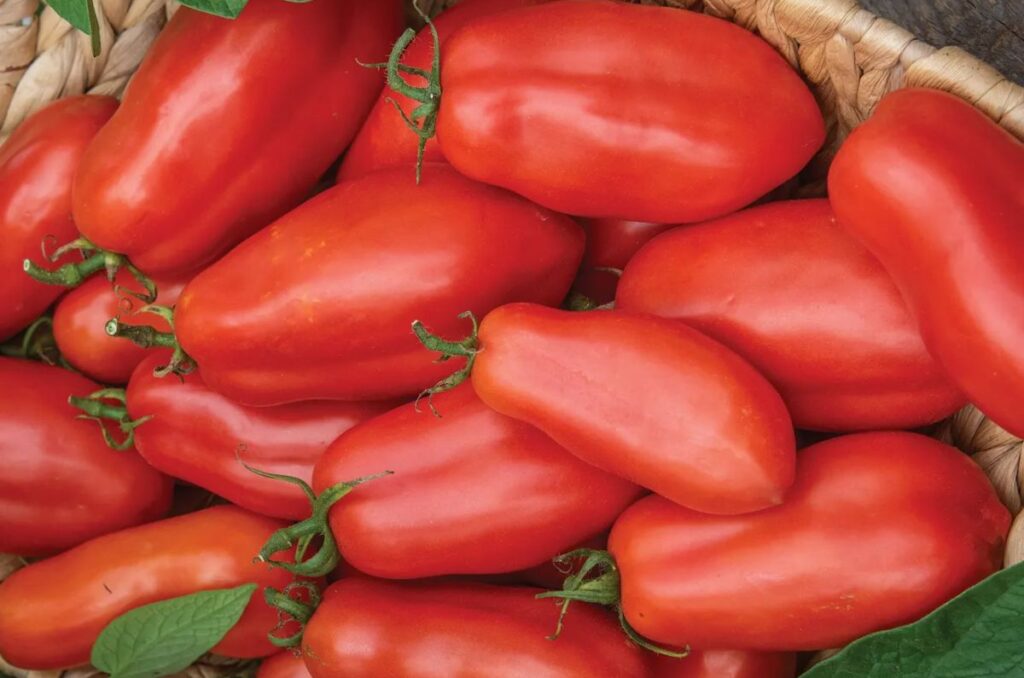
Indeterminate Tomato Varieties
Indeterminate tomatoes are varieties that will continue to grow vertically until the first frost in the fall. Basically, they grow forever. Most plants will consistently reach over 7 feet. The tallest tomato plant I ever grew was around 20 feet, which is crazy!
As long as the weather permits it, indeterminate tomatoes will constantly put out new growth and more fruit.
That being said, these tomatoes are going to need a trellis to grow properly.
These varieties are perfect for gardeners with long growing seasons and lots of vertical space.
Here are some of my favourite indeterminate tomato varieties:
- Sweetie: Matures in 65-70 days. A bite-sized tomato that is exceptionally sweet.
- San Marzano: Matures in 80 days. One of my all-time favourites, this Italian variety produces delicious meaty tomatoes meant for sauces and paste.
- Cherokee Purple: Matures in 85 days. This beautiful purple heirloom variety produces 5″ fruit that are rich and full of flavour.
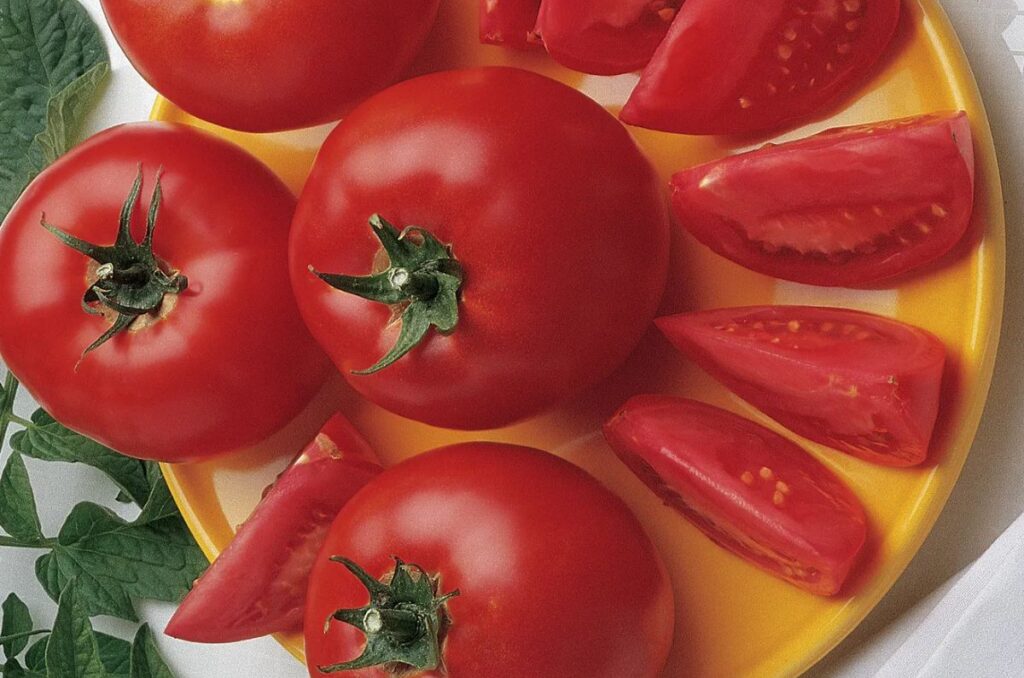
Determinate Tomato Varieties
On the other hand, determinate tomatoes have a set height limit that they cannot exceed, no matter how long your growing season is.
Most determinate tomatoes will grow 3-4 feet in height, with some dwarf varieties only reaching 1-2 feet.
This also means that you can only get a limited amount of fruit from determinate tomatoes. They will flower all at once and put all the fruit out at once.
These varieties are perfect for gardeners living in really cold climates, where the growing season is short. Or it is good for gardeners with a limited amount of vertical space.
Some of my favourite determinate tomato varieties are:
- Roma: Matures in 70 days. Another Italian plum tomato, perfect for making tomato sauce and paste.
- Veranda Red Hybrid: Matures in 55-60 days. A dwarf tomato variety that produces sweet cherry tomatoes on a foot-high plant.
- Early Girl: Matures in 65 days. An early-producing variety with 4″ fruits on plants that can support themselves.
If none of these varieties are for you, make sure to check out Burpee’s over 100 tomato varieties. You will definitely find one that is perfect for your garden.
How to Grow Tomatoes from Seed
I always like to start my tomatoes from seed. This way, I can get any variety that I want and give the plants the perfect growing conditions.
You should always start your tomato seeds indoors because that gives them the right amount of time to get established before going outside.
Here are my tips to start tomatoes indoors:
- Timing: Plant your tomato seeds about 6 weeks before the last frost date in the spring. This gives them enough time to grow strong and establish their roots.
- Lighting: Make sure you have adequate lighting to support the growth of your tomatoes. Consider using full spectrum LED grow lights to supplement light.
- Seedling Pots: Use small seedling cells to create an individual growing space for each tomato. Many nurseries carry them, or you can make your own from old containers and cardboard.
- Bottom Heat: Young tomato plants benefit from some supplemental heat. This can be achieved with a heat mat, which increases the temperature of the soil and helps the seeds to germinate and helps the young plants grow.
Hardening Off Tomatoes
If you are starting your tomato plants indoors, they need to be hardened off to produce a strong plant. Hardening off is the process of gradually exposing your plants to the outside conditions over a period of about a week.
To do this, wait until after the last frost date in your area. Then bring all your tomato seedlings outside for 2 hours, leaving them in the shade.
Gradually increase the time they are outside by 2 hours everyday and include some direct sunlight.
Make sure to keep them well-watered during this process, as direct sunlight is way hotter compared to indoor grow lights.
How to Grow Tomatoes in Containers
Tomatoes are an excellent plant for growing in containers, especially for gardeners in smaller spaces.
- Choose a large container, at least 5-7 gallons.
- Make sure the soil can hold onto water, because containers typically dry out quicker than raised beds.
- Add lots of compost or manure to the soil to provide beneficial microorganisms, organic matter, and trace nutrients.
- Make sure to stay on top of watering your containers, especially during the summer.
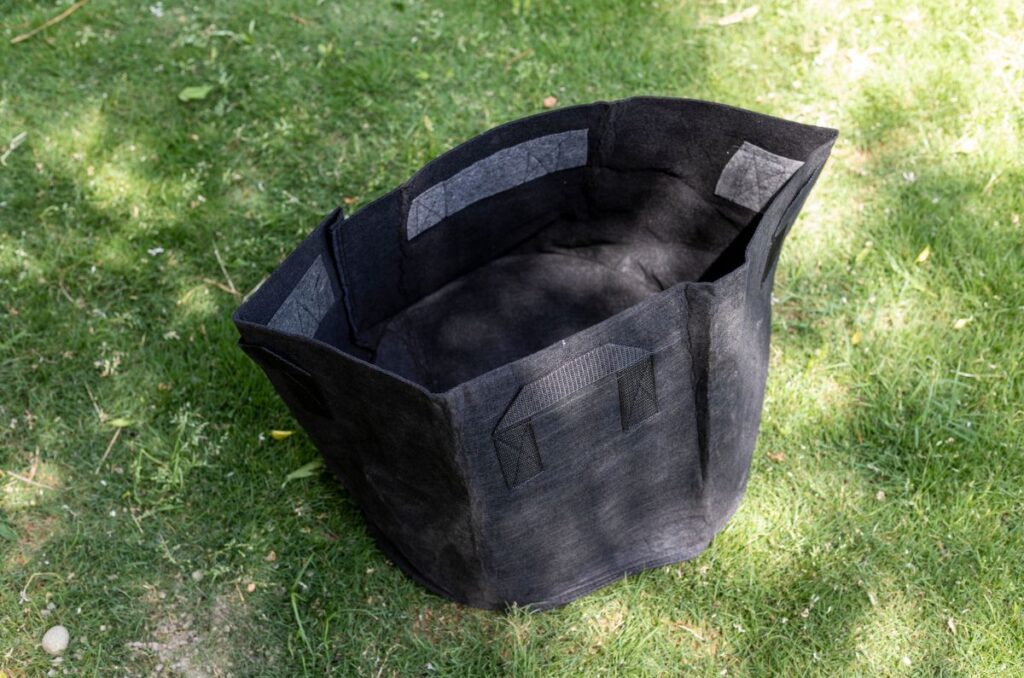
Are Grow Bags Good for Tomatoes?
Grow bags can be a good option for growing tomatoes: they are affordable, customizable, and lightweight. However, they are also very porous and can dry out very easily.
During the hotter months, you may have to water your grow bags with tomatoes every day.
What Tomatoes Grow Best in Pots?
Generally, the shorter tomato varieties will grow best in pots, containers, and grow bags.
Choose determinate and dwarf varieties to grow in pots, as these take up less space and have a smaller root mass. Here are my favourites:
- Veranda Red Hybrid: Matures in 55-60 days. A dwarf variety growing to only 20 inches in height.
- Sweetheart of the Patio: Matures in 68 days. Another dwarf tomato variety growing to about 30 inches tall.
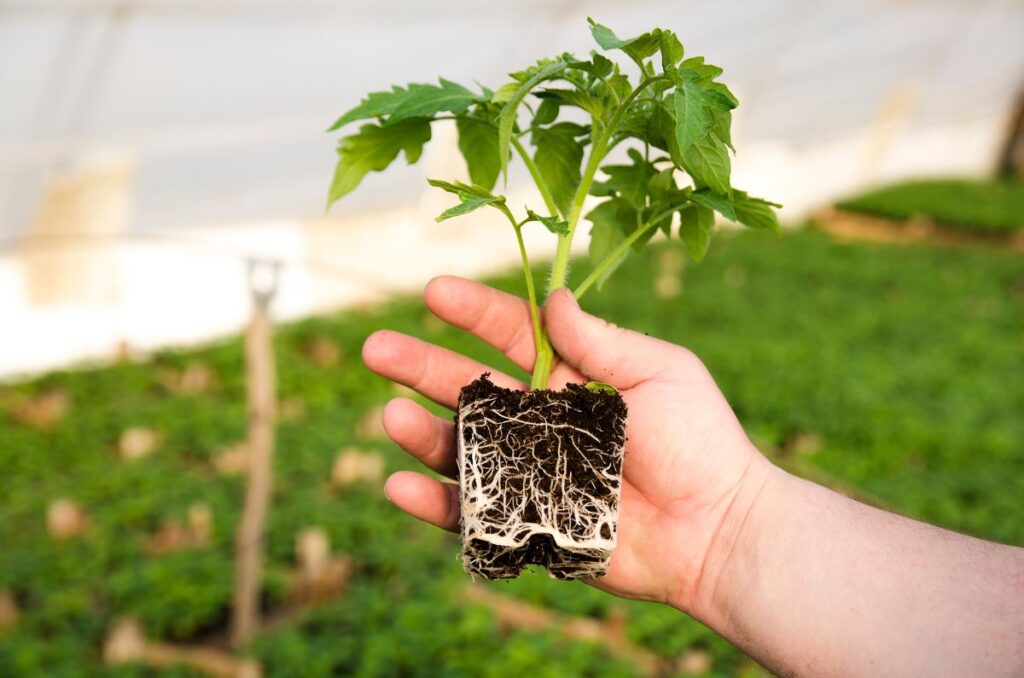
How to Plant Tomatoes
Make sure to transplant your seedlings outdoors after all the danger of frost has passed.
If you plant them before the last frost date, you risk the death of your tomatoes to frost.
Selecting the Right Location
Tomatoes need plenty of sunlight to grow and produce fruit, so make sure to choose a spot in your garden that receives 6 or more hours of direct sunlight per day.
Remember that tomatoes are a long-season crop, meaning that wherever you put them, they are going to be their until they die. That being said, choose your location carefully.
Preparing the Soil
Before planting your tomatoes, it’s essential to prepare the soil.
Tomatoes grow best in fertile and well-draining soil. Amend your soil with organic matter like compost or aged manure to improve its quality, nutrient content, and water retention.
You should also use a balanced organic fertilizer before planting to give your plants a boost.
You can grow in raised beds or in-ground. I prefer raised beds, as I can manage the soil better and improve it when I have to.
Planting the Tomatoes
Many people may be put off by the fact that you can and should actually bury the stems of your tomato plants.
This is because tomatoes (and other nightshades) can actually form new roots along the entire stem of the plant, known as adventitious roots.
So prepare the planting holes by digging deep enough to bury the stems up to the first set of true leaves. This encourages the plants to develop strong root systems.
Additionally, add a sprinkle of organic fertilizer at this point to give the tomatoes an early boost.
And we won’t be needing any of the bottom leaves, so make sure to remove those.
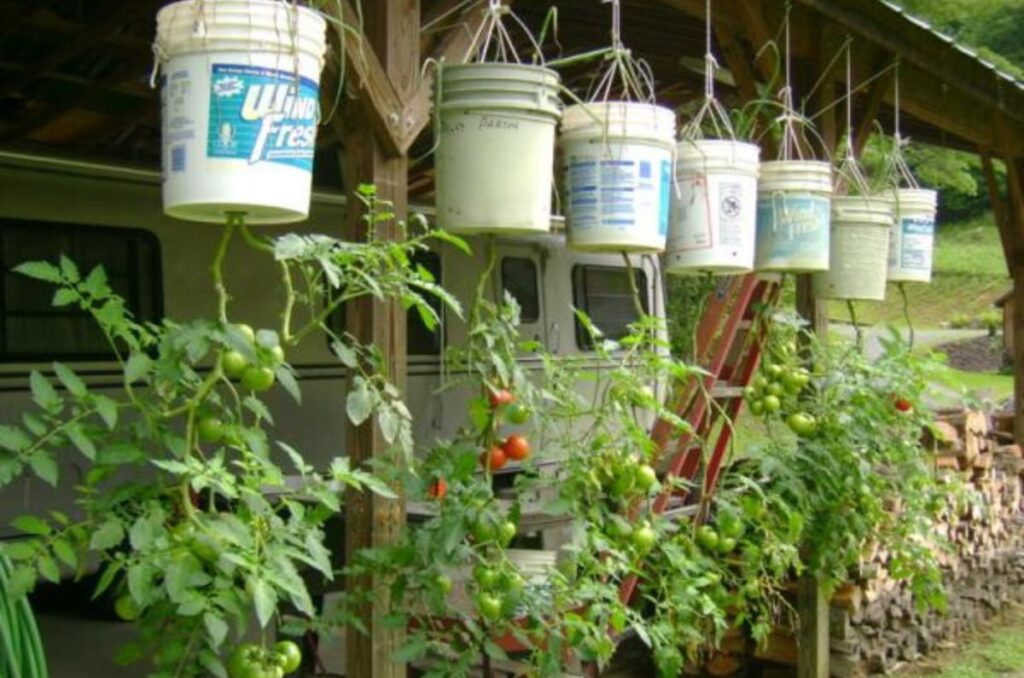
Can You Grow Tomatoes Upside Down?
This is a popular trend among backyard vegetable gardeners: growing tomatoes upside down.
While it is possible, I still can’t figure out a reason why anyone would do this. Maybe just to look cool, I don’t know.
To do this, you need a spot to hang a pot from, where the drainage holes are facing down. Then, plant your tomatoes with the stem coming out of the drainage hole at the bottom.
Every time you water, you have to water from the top of the pot. This can be a problem because the water might drain onto the leaves of the tomato. Just make sure it doesn’t happen.
It may look weird at first, but eventually the tomato plant will redirect itself and start growing upwards.
Again, I don’t know why anybody would do this, but it is possible to grow tomatoes upside down.
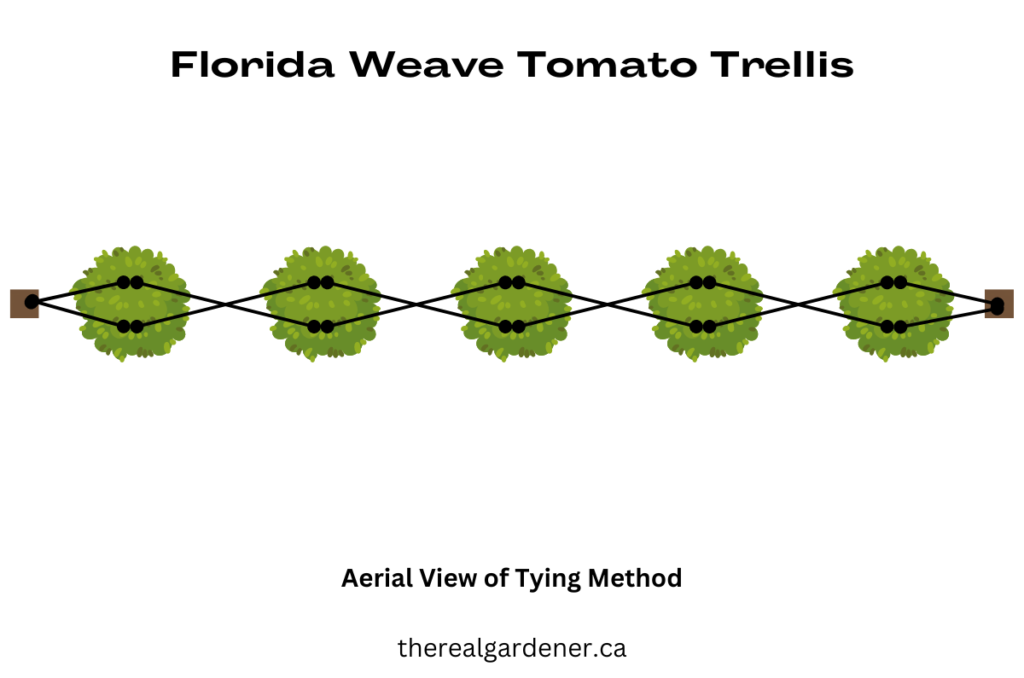
Do Tomatoes Need a Trellis?
Indeterminate tomatoes require some form of support to grow upright. You can use stakes, cages, or trellises to support the plants and prevent the fruits from touching the ground, which can cause rot and disease.
I like to use the Florida weave method. This trellising method involves placing a stake on either end of your tomato row, then weaving string in and out of each tomato plant, on either side of the stake.
This creates a strong and tight hold on the tomatoes, allowing them to grow upright.
You can also stake each plant individually, which is something I used to do a lot, and I still use it for some plants.
Watering Tomatoes
Tomatoes need consistent watering to thrive.
Water your plants deeply, especially during hot and dry periods. Deep watering encourages the roots to search for water leading to a stronger root system. Aim to provide about 1-2 inches of water per week, more if the weather is hot and dry.
Make sure to water at the base of the plant and not directly on the foliage, as wet leaves can lead to diseases.
Mulch your tomato plants with a thick layer of organic mulch. This helps to protect the soil and retain water during the summer.
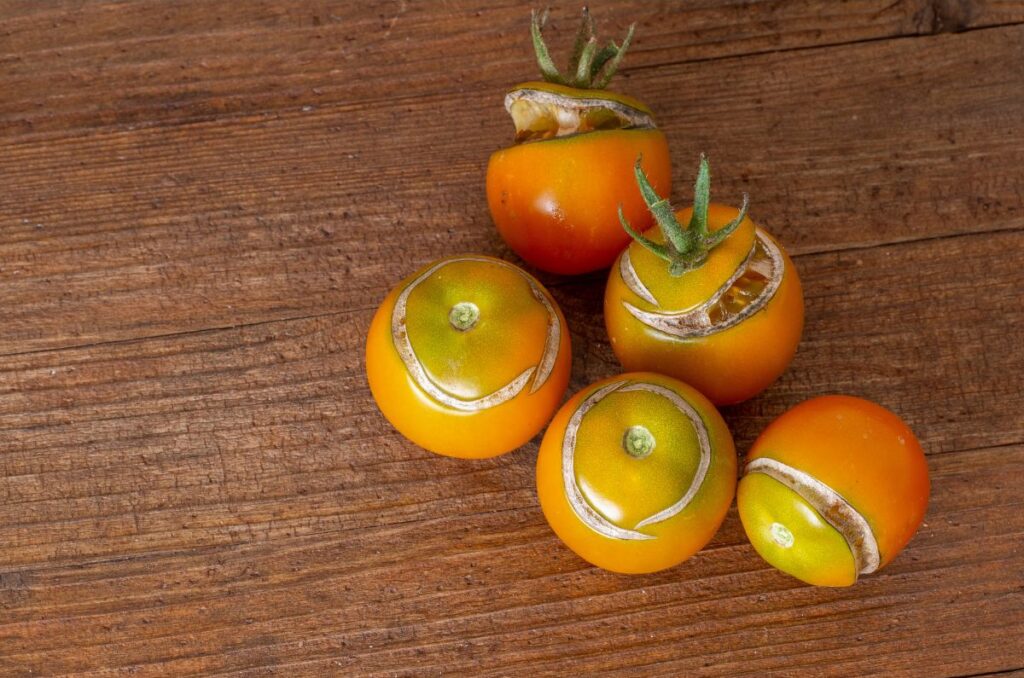
Preventing Cracking Tomatoes
Simply put, cracking is caused by overwatering
Sometimes tomatoes will crack after a huge rainfall. Just think about, the fruits are the very ends of the plant, so if they are filled with water, then where else can the water go?
The tomatoes have to crack in this case to get rid of excess water.
So to prevent this, just water your plants regularly and don’t water before it rains.
Some varieties are more prone to cracking, such as heirlooms.
Fertilizing Tomatoes
Tomatoes are heavy feeders and require regular fertilization throughout the season. You can use organic amendments like compost, aged manure, and bone meal to promote plant growth and fruit production. Follow the instructions on the fertilizer package for the best results.
Start with a high-nitrogen fertilizer at the beginning of the season, as nitrogen promotes leaf growth. A good fertilizer high in nitrogen is blood meal.
The best fertilizers for tomatoes when the plants are fruiting are those higher in phosphorus and potassium. This is because phosphorus and potassium promote flower and fruit production.
If you use a high-nitrogen fertilizer too late in the season, you may get less fruit and more leaves, which is not what we want.
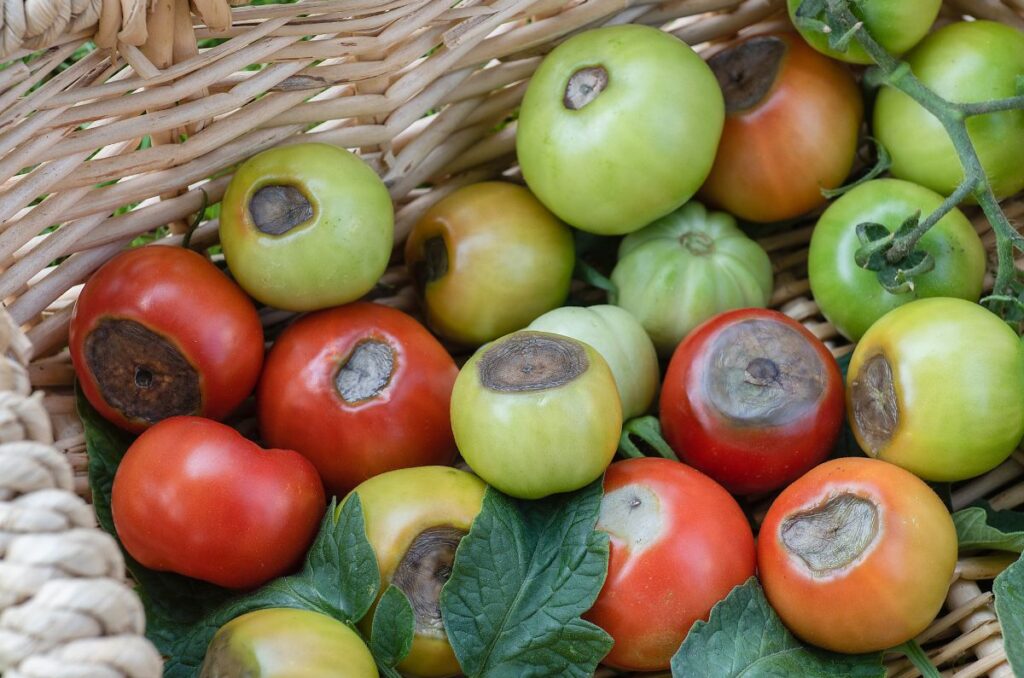
Is Blossom End Rot Caused by Calcium Deficiency?
This is one of the most common garden misconceptions out there.
Blossom end rot (BER) is technically caused by a calcium deficiency, which causes fruits on the plant to rot from the blossom end.
However, it is not because the soil is lacking calcium, it is because of uneven watering. When you water unevenly, tomato plants have trouble absorbing calcium, which leads to BER.
So don’t go adding a bunch of calcium to your soil just because you see one tomato with BER. Instead, first create a proper watering schedule for your plants.
Pruning Tomatoes
Tomatoes will benefit from some pruning to improve air circulation and fruit production.
There are these things on tomato plants called suckers. Suckers are the small stems that grow between the main stem and a leaf.
For indeterminate tomatoes, most suckers should be removed, simply because they produce so many of them. But I do like to leave at least 2-4 suckers on each plant. I have found that this leads to more fruit production.
Some people will say that you should remove all of the suckers and just leave the main stem to grow, but I don’t believe that this works for home gardeners who are trying to get the best harvest in a smaller space.
All suckers on determinate tomatoes should be left on to produce fruit.
Additionally, prune off any leaves that are very close to the ground, any leaves that are diseased, or any leaves that don’t have access to direct sunlight. These leaves are not doing anything for the plant and should be removed.

Managing Tomato Pests
Avoid using synthetic pesticides, as these can be harmful for your garden and for your own health. If you wanted synthetically-grown food, you would go to the grocery store. But you are a home gardener, so choose organic.
Tomatoes are susceptible to many common garden pests, so it’s important to stay on top of pest control. Here are some tips:
- Some common tomato pests include: aphids, spider mites, and tomato hornworms.
- Regularly check each tomato plant for signs of pests. Check under the leaves, around the fruits, and near the soil.
- Choose organic methods to get rid of pests, such as insecticidal soap spray, neem oil spray, or handpicking.
- Insecticidal soap and neem oil works for small pests like aphids and spider mites. These have soft bodies and will be killed with the soap or oil.
- Handpicking is better for tomato hornworms, as they are typically much larger and have a resistance to the sprays.
Harvesting Ripe Tomatoes
Many people will wait until the tomato fruits are perfectly ripe on the vine before they pick it. But I’m here to tell you that that is unnecessary.
You see, tomatoes reach their peak flavour when they are about 50% ripe. This means that a half ripe tomato and a fully ripe tomato will pretty much taste the same.
By picking your tomatoes early, you reduce the risk of them being eaten by pests, like birds and squirrels (those devils)
Additionally, this also extends their shelf life. When you pick a tomato that is fully ripe, you pretty much have to use it that day or it goes bad. When you pick them at 50% ripeness, you have more time to use the tomatoes before they go bad.
Frequently Asked Questions
Wait to plant tomatoes outdoors until there is no danger of frost. Planting times will vary depending on your climate. In general, tomatoes are warm-season vegetables that prefer warm soil temperatures.
Most tomato varieties take about 60-70 days to mature. This means that after about 2-3 months, you will be harvesting your first tomatoes.
Tomatoes can be growing without a cage, but indeterminate varieties need some kind of support trellis. You can make your own using the Florida weave or by using a few stakes.
Growing tomatoes with herbs is an amazing idea! Herbs like basil and rosemary help to deter common tomato pests with their strong scents.
Any part of a tomato plant stem will grow roots, meaning you can grow tomatoes from stem and sucker cuttings. Check out this video where I propagate tomato plants from cuttings.
Dwarf tomato varieties can be grown on a balcony or patio. This is because they take up less space and require less light than other tomato varieties.
Learn More About Tomatoes
Here are a few more posts to get the ball rolling in your garden!
- The Best Fertilizer for Tomatoes to Grow Juicy Fruits
- How to Grow Beans from Seed to Harvest
- 5 Indeterminate Tomato Trellis Ideas
If you liked this article, make sure to share it with your friends and family members who are also looking to sharpen their gardening skills. Also, consider signing up for our email newsletter; don’t worry, we won’t send you spam, just fresh gardening ideas every week!
If you want to learn more about vegetable gardening, check out The Real Gardener on LinkedIn, YouTube, and Pinterest.
Pin this post for later:
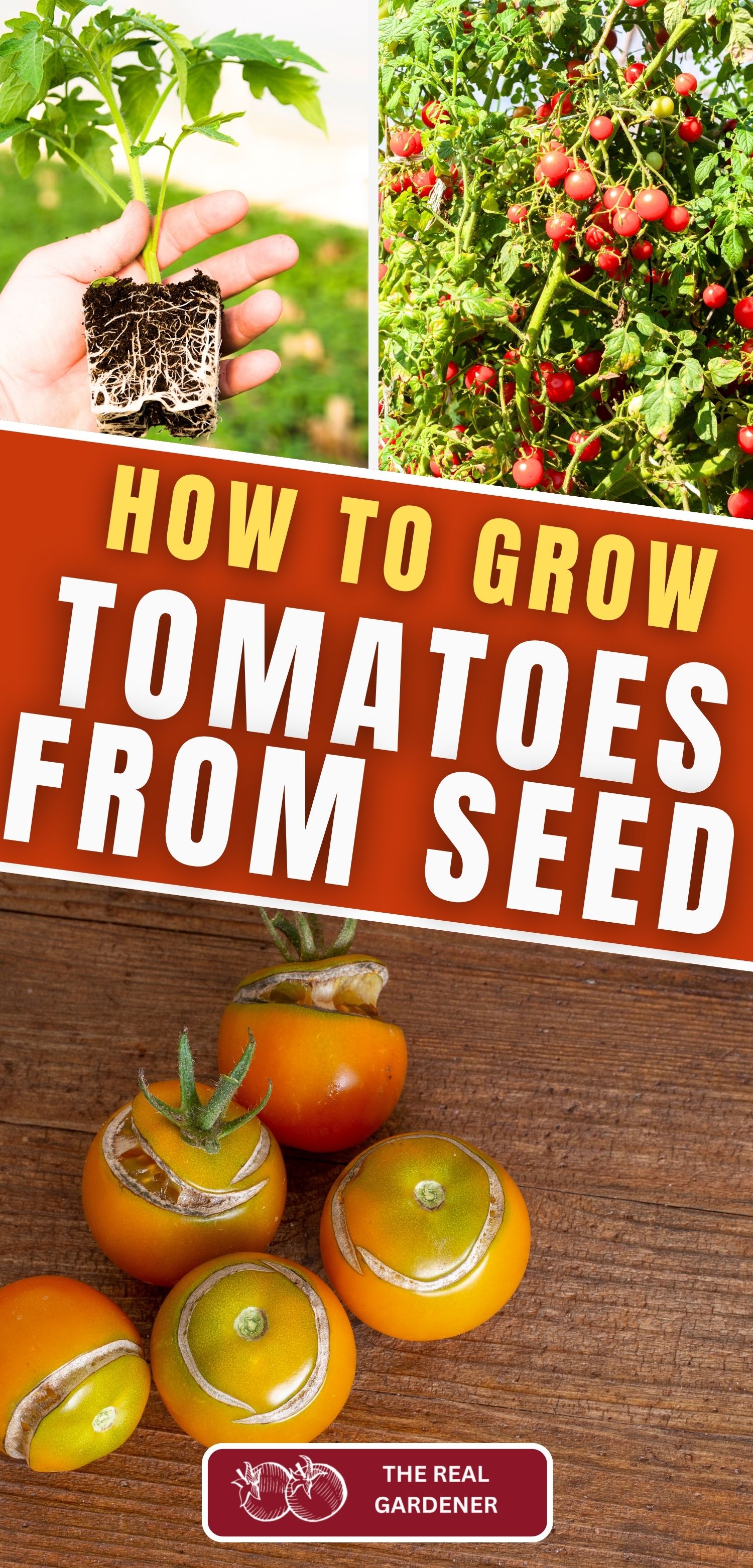
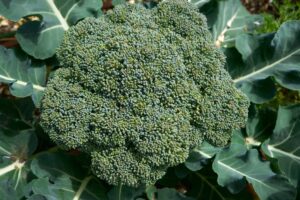
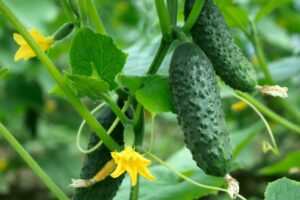


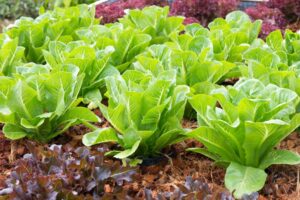
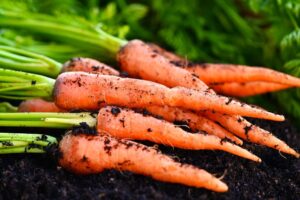
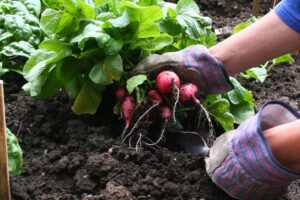
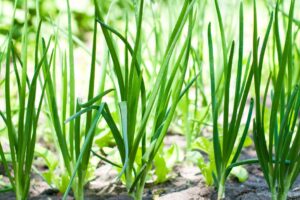
Leave a Reply